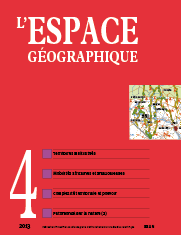

Geneviève CORTES, Denis PESCHE. Multi-sited territory
Multi-sited territory, territorial complexity and territorial postmodernity: a relevant conceptual toolbox for tackling contemporary territorialities? (4 fig., 1 photo, 1 tabl.)
This paper discusses the relevance of the concept of “multi-sited territory”, proposed for the specification of spatial entities associating non-contiguous places sharing a coherent territoriality. Such a concept would be in accordance with the relational nature of socio-spatial analysis challenging the “territorial trap” and its container methodologism resulting from the modern way of designing regions. For this reason, it seems essential for us to address simultaneously the concept of “territorial postmodernity” related to the context which makes it possible to conceive the “multi-sited territory”, and the concept of “territorial complexity” pertaining to the simultaneous production of territories with different natures. The analysis of the noticeable South African territorial experiences illustrates with exacerbation each of these concepts and the political contradictions that they express.
keywords: MULTI-SITED TERRITORY, NETWORK, POSTMODERNITY, SITUATION, SOUTH AFRICA, TERRITORIAL COMPLEXITY, TERRITORY
Is the international transhumance corridor in Sahel an archetype of multi-sited territory? (4 fig.)
Corridor is a common contemporaneous feature in spatial development policies. It makes it possible to promote and protect mobility in a system with numerous boundaries. Thus in Sahel where zoning and territorialization have progressively bounded the open space, transhumance and herder’s way of life need equipped and secure corridors. If the corridor is an assemblage, which combines the passageway for its linking function along with nodes and gateways, then it deals with territoriality. But would it be pertinent to use the expression “multisited territory” for qualifying the international transhumance corridor in Sahel? This paper attempts to respond to this question by analyzing the experience in assembling this international transhumance corridor in Sahel and by taking into account its political dimension.
keywords: CORRIDOR, TRANSHUMANCE, MULTI-SITED TERRITORY, NATURAL RESOURCE MANAGEMENT, SAHEL, SHARED RESOURCE
François-Michel LE TOURNEAU. Construction of multi-sited territories in Amazon. The case of Quilombolas from Trombetas (Pará, Brazil)(4 fig.)
We explore the rationales behind the multi-sited territories of quilombolas communities (descendants of maroons) in the Amazon. Their mobility systems, based on family residential dispersion and complementarities, run on remote spaces, both rural and urban. A system of collective rules of membership and rights ensures territorial continuity between spaces, and gives a sense to the multisited territory. We then discuss the challenges associated with the recent reconfiguration of these areas, in the light of changes in production systems and demands on environmental management.
keywords: AMAZONIA, COMMUNITY BASED MANAGEMENT, MOBILITY, PROTECTED AREA, TRADITIONAL PEOPLE
Multi-sited territories and migratory circulation (4 fig., 3 photos)
The “multi-sited” territory emerged in a context of increased mobility, where reticular systems are better able to express contemporary spatiality. This article is based on research conducted in the Kayes Region (Mali) where international migration is a resource. With the advent of democracy and decentralization, original villages are classified according to new municipal divisions. Beyond the opposition between network and territory, we are suggesting the notion of a “multi-sited” territory as a way to rethink the relationship to distance, which is the basis of all spatiality, transforming it into a territory-resource that re-examines the local production of space in a mobile world.
keywords: DISTANCE, INTERNATIONAL MIGRATION, MULTI-SITED TERRITORY, MUNICIPAL DIVISION, RESOURCE
Renaturalizing without heritage status. Banishing disused installations and landscape blights in the protected alpine areas (2 fig., 1 photo)
This paper examines the absence of heritage processes and the removal of obsolete installations. The latter have been regularly dismantled since the 1990s in protected areas of the French Alps. The process has, in turn, resulted in the mountain range being considered an area with high heritage value. In an era when the concept of “heritage” is applied ubiquitously, these projects consist in denying heritage and “re-naturing” spaces in hopes of complying with social norms. Such processes must satisfy a triple discourse: rescuing protected spaces, protecting the exemplarity of such actions, and cleaning up nature.
keywords: CLEANING, FALLOW AREAS, FRENCH ALPS, HERITAGE, PROTECTED NATURAL AREA
The meaning and role of natural heritage within a context of sustainable planning and climate change
The idea of sustainable development and most particularly the challenge set by climate change are currently redefining the meaning and role of natural heritage in the planning process. This article examines two ways of approaching this redefinition: resistance heritage and resilience heritage.
keywords: ADAPTATION, NATURAL HERITAGE, RESILIENCE, SUSTAINABLE DEVELOPMENT
L’espace géographique 3/13![]()
![]() L’espace géographique 1/14
L’espace géographique 1/14
For subscribe or buy this issue: BELIN
![]() L’Espace géographique: contents
L’Espace géographique: contents
Last modified: January 24, 2014